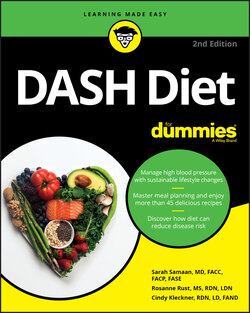Читать книгу DASH Diet For Dummies - Sarah Samaan - Страница 61
Increasing the quantity of fruits, vegetables, nuts, seeds, and beans
ОглавлениеThe first strategy for adding more plant foods to your diet is making sure you have them available. Face it — you won’t eat right if all you have in the fridge is a jar of mustard and some pickles. Adding fruits and vegetables to your weekly shopping list is a must. These foods contain a good amount of potassium, an important mineral for healthy hearts.
Having easy, ready-to-eat access to these foods in the refrigerator is helpful. When you purchase vegetables, store them in the crisper bin in the refrigerator; they’ll last longer. Keep some washed, cut, and ready to eat in airtight containers so grabbing them is easy. The same goes for fruit: Keep it stored in a fruit bin, and keep fruits that perish more quickly (bananas, berries, and so on) on your running grocery list so you always have them on hand.
Try these time-saving strategies to help get you eating more fruits and vegetables:
When you bring home melon, take a few minutes to cut it, remove the rind, and cube it for snacking. Keep it in an airtight container in the refrigerator. If fruit is clean and ready to grab when you want to eat it, you’ll eat more of it and throw less away.
Keep a vegetable snack box in the fridge too. Put sliced celery sticks, sweet bell pepper slices, and mini carrots into a zippered bag and keep it in sight when you open the refrigerator. Use these as snacks before dinner or pack them in your lunch. Dip them into a yummy Greek yogurt dip and enjoy.
Keep bananas on the counter where you can see them and easily grab one on the go. Eat one each day, before they go brown (although those make great DASH muffins). Add them to oatmeal or yogurt or just eat them as is for a quick snack.
Wash and freeze stemmed grapes for a refreshing snack in warmer months, or try cutting a banana into 1-inch chunks, dipping one end in melted dark chocolate, and freezing — a delicious, potassium-filled frozen treat!
Swap the salt-ridden taquitos that may have once inhabited your freezer for frozen fruits and vegetables — a quick and economical choice.
Spread peanut butter lightly onto whole-wheat toast or an oat bran English muffin and top with sliced strawberries or bananas and a sprinkling of flax seed for a midday snack.
Make a yogurt parfait with nonfat plain Greek yogurt, 2 tablespoons granola, and fresh fruit.
Cook spinach the night you bring it home, even if you don’t eat it then. Cooked spinach lasts a few more days in the refrigerator and is easy to reheat in a microwave or saucepan and add to eggs or a pasta or rice dish. You can also cook half of it and use the rest as sandwich toppers for your lunches. Spinach only takes about 5 minutes to cook. Bring a large pot of water to a boil, add the spinach, cover, let simmer for 2 to 3 minutes, and drain. You can also sauté it with onion and garlic in a smidge of healthy olive oil.
Keep dried fruits such as apricots, raisins, and cranberries on a prime pantry shelf for a quick snack or to add to salads and other recipes.
Mix up a fruit smoothie for breakfast or for an after-work snack while you’re getting dinner together. Place 1 cup of frozen or fresh berries or a frozen banana into a high-speed blender with ½ cup of Greek yogurt (if you’re using fresh fruit, pop in two to three ice cubes). Blend until smooth.
Keep canned beans and canned tomato products on hand. Some of these items are higher in sodium, but they’re loaded with important antioxidants. And you can remove some of the sodium by rinsing and draining beans before using.
Keep frozen peas or other no-salt vegetable blends on hand for a quick side dish or to add to pasta or rice dishes.
When you first glanced at the DASH diet, you may have said out loud: “What? Eat 4 to 5 servings of vegetables every day? And eat 4 to 5 servings of fruit too?!” But alas, friends, there is comfort in the answer to the question “What is a serving?” Table 4-1 gives you the lowdown.
TABLE 4-1 Serving Sizes of Fruits and Vegetables
| Food | 1 Serving |
|---|---|
| Apple, orange, peach, pear | 1 medium |
| Kiwifruit | 1 |
| Banana, medium-large | ½ |
| Raisins, dried cranberries, dried cherries | ¼ cup (or 4 tablespoons) |
| Frozen, canned, or fresh mixed fruit | ½ cup |
| Fruit juice | 6 ounces |
| Raw vegetables | 1 cup |
| Cooked vegetables | ½ cup |
| Low-sodium vegetable juice | 6 ounces |
So with the information in Table 4-1, you know that if you slice up a large apple or a large banana for your midday snack, you can count that as 2 servings. Most dinner salads at restaurants are also 2 servings. Add 4 tablespoons of dried fruit to that salad and you’ve got another serving of fruit. Throw 1 cup of frozen strawberries into the blender with some low-fat yogurt and you just included another serving of fruit! See how easy this 4-to-5 servings rule is?
In addition to the fruit and vegetable groups, you want to add nuts, seeds, and dried beans to your diet. These high-protein foods are considered to be part of the meat/protein food group. In addition to protein, they provide nutrients and fiber. Serving sizes are important here too. Just ⅓ cup of nuts equals 1 serving. A serving of seeds is just 2 tablespoons, and a serving of beans is ½ cup.
